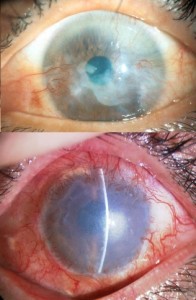Oral Stem Cells Can Cure Certain Types of Blindness


Eyes with limbal stem cell deficiency. From: Dr. Nakamura, Dpt. of Ophtalmology, Kyoto Prefectural U. of Medicine.
Scientists from the University of Oslo have cured a special type of blindness by culturing and implanting stem cells from the own patients mucosa in the damaged cornea. The research team also found out that the optimum storage and transport temperature for cultured cells is between 12 and 16 ºC. The results have been published in the journal PLOS ONE.
Limbal stem cell deficiency can be hereditary or caused by UV irradiation, infections or chemical burns. It affects 1.5 million people in India only. Normally, limball stem cells renew the outer layer of the cornea. Lack of stem cells in this part of the eye allows other cells to occupy the outer cornea, causing partial or total blindness and severe pain due to exposure of a highly innervated region.
Since the late 90s, the disease could be treated by collecting cells from the patient´s healthy eye, which was not always available. Other option relied on harvesting them from relatives, but this has associated problems of histocompatibility. The last improvement arrived when it was discovered that mucosa and cornea cells are similar enough to be used in autotransplantations. The major problem, however, is the quick access to the few laboratories worldwide where the mucosa cells are cultured.
Tor Paaske Utheim has been trying to restore his patients’ vision by transplanting in the eye stem cells originated from different tissues. Dr. Utheim has recently focused on cells from the mucosa. Storage and transportation of stem cells are another focus of Utheim´s research. Years ago, he designed small custom-made plastic containers that are much more practical than previous bulkier ones. This finding helps streamlining the transportation and transplantation processes.
A small container at 16 ºC is ideal for maintaining stem cells properties
A PhD student under Utheim´s supervision, Rakibul Islam, has been working on improving cell transport and storage methods. In collaboration with Harvard Medical School, Islam has proven that cells maintain their properties at 16 ºC better than at the commonly accepted 37 ºC. The cells can be safely stored for a week in a sealed container, which facilitates transportation to remote places, microbiological testing and transplantation planning.
Cells from the mucosa are renewed very quickly. Islam has been testing which parts renew faster and are better sources for regenerative medicine. However, the results have not been published yet.
250 people have so far been autotransplanted with their own mucosa cells. 75% of the procedures were successful.
Dr. Utheim´s research team is currently trying to grow mucosa cells on contact lenses that would be later placed in the damaged eye, simplifying the transplantation procedure.
This finding is a perfect example of the importance of interdisciplinary research, in this case between dentists and ophtalmologists. The results are relevant for other fields: transportation and storage temperatures for other tissues might be revised.
Source: University of Oslo

